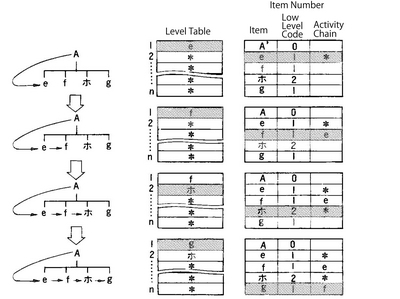MRP glossary TOP > Material Planning > Activity Chain
Activity Chain
Activity Chain
Activity Chain is used to control the sequence of explored items of each level, in order to implement MRP level by level. This chain, which is usually set in an item, controls the horizontal expansion of the product structure, while Level Table controls the depth of that. The figure shows the relationship between Level Table and Activity Chain. Here, it is assumed that e, f, and g among the low-level items of Product A are all low-level code 1, while only item "ホ" is level 2. First, Part e is explored. In the Level Table, "*" is pre-entered as an initial value. Enter this "*" in the Activity Chain of the explored Item e, and then enter Item e in the first level of Level Table. Next, Item f is explored. Its low-level code is still 1. Move "e" entered in the Level Table to the Activity Chain of Item f, and enter Item f in Level Table. In this way, the explosion is going on by repeatedly setting Activity Chain and entering values in Level Table.

Try to confirm whether or not the items of level 1 are chaining in this explosion. First, "g" is being entered in the level 1 of Level Table. Next, Part f is entered in Activity Chain of Item g; Part e is set in Item f; "*" showing the end of chaining is set in Item e, which means the items are connected together in a line from g to End (*) via f and e (like g -> f -> e -> End (*)). This sequence allows Requirements Explosion to perform level by level, which is necessary for MRP.
Related term: Requirements Explosion,Level Table,Low Level Code
Activity Chain is used to control the sequence of explored items of each level, in order to implement MRP level by level. This chain, which is usually set in an item, controls the horizontal expansion of the product structure, while Level Table controls the depth of that. The figure shows the relationship between Level Table and Activity Chain. Here, it is assumed that e, f, and g among the low-level items of Product A are all low-level code 1, while only item "ホ" is level 2. First, Part e is explored. In the Level Table, "*" is pre-entered as an initial value. Enter this "*" in the Activity Chain of the explored Item e, and then enter Item e in the first level of Level Table. Next, Item f is explored. Its low-level code is still 1. Move "e" entered in the Level Table to the Activity Chain of Item f, and enter Item f in Level Table. In this way, the explosion is going on by repeatedly setting Activity Chain and entering values in Level Table.

Try to confirm whether or not the items of level 1 are chaining in this explosion. First, "g" is being entered in the level 1 of Level Table. Next, Part f is entered in Activity Chain of Item g; Part e is set in Item f; "*" showing the end of chaining is set in Item e, which means the items are connected together in a line from g to End (*) via f and e (like g -> f -> e -> End (*)). This sequence allows Requirements Explosion to perform level by level, which is necessary for MRP.
Related term: Requirements Explosion,Level Table,Low Level Code
Reference:JIT Business Research Mr. Hirano Hiroyuki
